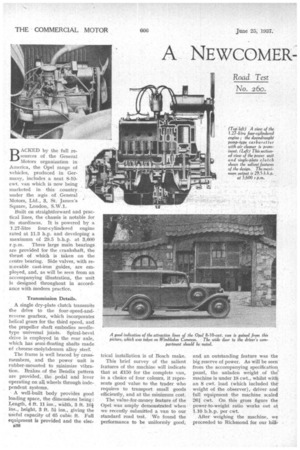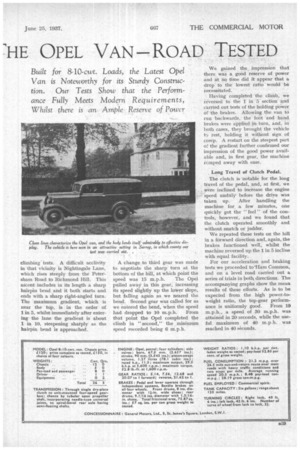A NEWCOMER HE OPEL VAN ROAD TESTED
Page 52

Page 53

Page 54

If you've noticed an error in this article please click here to report it so we can fix it.
BACKED by the full resources of the General Motors organization in America, the Opel range of vehicles, produced in Germany, includes a neat 8-10Cwt. van which is now being marketed in this country -ander the agis of General Motors, Ltd., 3, St. James's Square, London, S.W.1.
Built on straightforward and practical lines, the chassis is notable for its sturdiness. It is powered by a 1.27-lltre four-cylindiered engine rated at 11.3 ILI). and developing a maximum of 29.5 b.h.p. at 3,600 z.p.m. Three large main bearings are provided for the crankshaft, the thrust of which is taken on the centre bearing. Side valves, with ren. ovable cast-iron guides, are employed, and, as will be seen from an accompanying illustration, the unit is designed throughout in accordance with modern practice.
Transmission Details.
A single dry-plate clutch transmits the drive to the four-speed-andreverse gearbox, which incorporates helical gears for the third speed, and the propeller shaft embodies needletype universal joints. Spiral-bevel drive is employed in the rear axle, which has semi-floating shafts made of chrome-molybdenum alloy _steel% The frame is well braced by crossmembers, and the power unit is rubber-mounted to minimize vibration. Brakes of the Bendix pattern are provided, the pedal and lever operating on all wheels through independent systems.
A well-built body provides good loading space, the dimensions being : Length, 4 ft. 11 ins., width, 3 ft. 10i ins., height, 3 ft. 5* ins., giving the useful capacity of 65 cubic ft. Full equipment is provided and the elec 38 trical installation is of Bosch make.
This brief survey of the salient features of the machine will indicate that at £150 for the complete van, in a choice of four colours, it represents good value to the trader who requires to transport small goods efficiently, and at the minimum cost.
The value-for-money feature of the Opel was amply demonstrated when we recently submitted a van to our standard road test. We found the performance to be uniformly good, and an outstanding feature was the big reserve of power. As will be seen from the accompanying specification panel, the unladen weight of
machine is under 18 cwt., whilst with an 8 cwt. load (which included the weight of the observer), driver and full equipment the machine. scaled 261 cwt. On this gross figure the power-to-weight ratio works out at 1.10 b.h.p. per cwt.
After weighing the machine, we proceeded to Richmond for our hill climbing' tests. A difficult acclivity in that vicinity is Nightingale Lane, which rises steeply from the Petersham Road to Richmond Hill. This ascent includes in its length a sharp hairpin bend and it both starts and ends with a sharp right-angled turn. The maximum gradient, which is near the top, is in the order of 1 in 5, whilst immediately after entering the lane the gradient is about 1 in 10, steepening shafply as the hairpin bend is approached. A change to third gear was made to negotiate the sharp turn at the bottom of the hill, at which point the speed was 15 m.p.h. The Opel pulled away in this gear, increasing its speed slightly up the lower slope, but falling again as we neared the bend. Second gear was called for as we entered the bend, when the speed had dropped to 10 m.p.h. From that point the Opel completed the climb in "second," the minimum speed recorded being 6 m.p.h.
We gained the impression that there was a good reserve of power and at no time did it appear that a drop to the lowest ratio would be necessitated.
Having completed the climb, we reversed to the 1 in 5 section and carried out tests of the holding power of the brakes. Allowing the van to run -backwards, the foot and hand brakes were applied in turn, and, in both cases, they brought the vehicle to rest, holding it without sign of creep. A restart on the steepest part at' the gradient further confirmed our impression of the good power available and, in first gear, the machine rGmped away with ease.
, Long Travel of Clutch Pedal.
The clutch is 'notable for the long travel of the pedal, and, at first, we were inclined to increase the engine speed unduly' before the drive was taken up. After handling the machine for, a few minutes, one quickly got the " feel " of the controls, however, and we found that the clutch operated smoothly and without snatch or judder.
We repeated these tests on the hill in a forward direction and, again, the brakes functioned well, whilst the machine reversed up the 1 in 5 incline with equal facility.
For our acceleration and braking tests we proceeded tol-lam Common, and on a level road carried out a series of trials in both directions. The accompanying graphs show the mean results of these efforts. As is to be expected from the high power-toweight ratio, the top-gear performance is uniformly good. From 10 m.p.h., a speed of 30 m.p.h. was attained in 20 seconds, while the useful maximum of 40 m.p.h. was reached in 40 seconds. Whilst the engine was capable of propelling the vehicle at a speed in excess of 40 m.p.h., such speeds should not be required and, if indulged in to any. extent, will obviously increase wear.
_Third gear (7.56 to 1) appeared to be well chosen and• fairly quick changes could be made Hip or down" when circumstances required. Little was to be gained, however, by overdoing the use of the third ratio, as the flexibility in direct gear called for the minimum of gear changing.
Although it is not to be recommended as normal practice, we tested the flexibility of the power unit by dropping to the lowest possible speed from which the machine would pull away in top gear. Without undue delicacy of touch on the accelerator pedal, we found that the engine would pick up the load progressively without sign of distress from a speed as low as 5 m.p.h.
Reference to the graph illustrating the results of our braking tests, shows that the decelerative powers of the Bendix brakes are well up to the _ standard called for to day. The self-energizing effect of the shoes calls, however, for careful manipulation of the pedal, and we found that if the foot brake were applied with undue vigour, particularly from the lower speeds, the machine is apt to slide, due to the wheels locking.
Braking Results.
As an example, we made several tests from 25 m.p.h. and, treating the situation as an emergency and stamping on the pedal, a stop was made in 38 ft. Treating the brake pedal more gently front, the same speed, with the result that the smoothness A deceleration was greatly improved, increased the stopping distance to 424 ft. A noteworthy feature of the curves is that the results show the band brake to be little inferior to the foot brake.
Our consumption test was carried out from a point on the Chiswick Bypass, through Richmond and Kingston to Esher, thence via Leatherhead and Surbiton back to Kingston, and from there we returned,. by the same route as on the outward journey, to our starting point. The total distance was 26.5 miles and, to simulate delivery conditions so far as possible, a stop was made twice in each mile.
Heavy traffic conditions were met B40 during the major portion of the run, and this called for extensive use of the gears. Several hills, requiring a change to third gear, were also encountered, but, despite these checks and rather more than 50 stops, the course was completed at an average speed of 20.3 m.p.h.
Fuel Consumption Tests._ It will be seen then, that no effort was made to spare the van with a view to gaining the minimum consumption, and the return of 21.2 m.p.g. is representative of the result likely to be obtained under heavy conditions of operation. A second test under easier conditions, and without including a number of stops and starts, returned a figure of 24.1 m.p.g.
During our spells at the wheel, we found the van extremely simple to drive. The gear change was easy and the steering light and accurate. We noted that the steering had little self-centring action and its lightness is, perhaps, largely due to this fact. At the same time, the layout of the steering gear has been so arranged that there is no tendency to wander at the higher speeds.
Starting the engine calls for a procedure different from that normally employed, due -to the provision of a downdraught pump-type carburetter. Once it is grasped that the throttle should be opened fully if the engine does not start the first time the starter pedal is depressed, no trouble is likely to be encountered, and the engine starts quickly and surely.
Good equipment is provided and includes a five-lamp lighting set, windscreen wiper and direction indicators. A foot-operated dipping switch is nicorporated in the headlamp circuit. Safety glass is used for all windows.
4 75 17' TYRE3 r .51eV The body is well proportioned and large -doors give easy entry to and exit from the driver's and passenger's seats. A full-width door is provided at the rear and a minor criticism is in respect of the windows in the reac door. These are on the small side so that, when reversing, only limited vision is available to the rear.
An inspection of the chassis shows it to be sturdily built, whilst the performance of the vehicle in our hands leads us to believe that it represents an excellent value-for-money proposition.




























































































